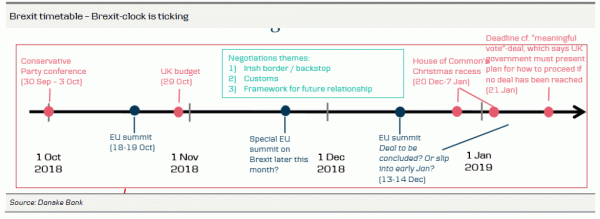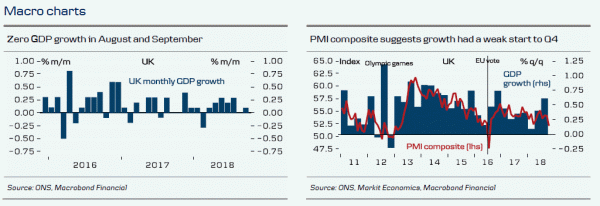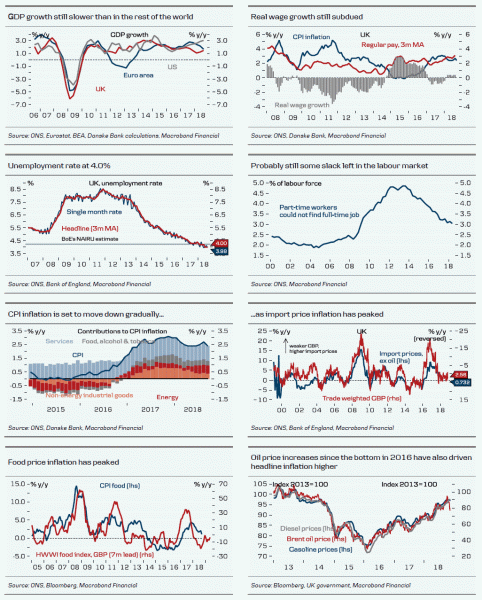UK politics remain poisoned, as PM Theresa May tries to find a final compromise in her Cabinet to unlock the negotiations with the EU. The ambition was to have a full draft withdrawal text ready early this week but the decision may be postponed further, as May’s proposal is under fire. As the withdrawal text is 95% done, there is still no agreement on the backstop solution to the Irish border (i.e. how does one avoid a hard border between Ireland and Northern Ireland if the UK and the EU fail to reach an agreement on the permanent future relationship during the transition, which removes the need for a hard border). PM Theresa May is trying to downplay the importance of the backstop, as she says it would never come into force anyway. She argues the deal on the future relationship will remove the need of a border but it is still causing a lot of trouble politically.
As the UK has rejected the idea to let Northern Ireland stay in the customs union (CU) and EU single market, May’s proposal is to keep the whole UK in the CU. Apart from the fact that the UK cannot make new trade deals with other countries while staying in the CU, the EU has also said it demands the UK to stay closely aligned with EU regulation (and maintaining fishing rights in British waters) and that the UK cannot unilaterally leave the CU. It seems like May has accepted there must be a joint UK-EU exit mechanism, which has infuriated both remainers and Brexiteers, see The Guardian. The EU also demands there is a ‘backstop to the backstop’, if there is to be an exit mechanism, which May also seems to have accepted. This ‘backstop to the backstop’ is just the original idea of keeping Northern Ireland inside the CU and single market. This has upset the Democratic Unionist Party (DUP) in Northern Ireland, who says it cannot vote for anything that may lead to a border between Great Britain and Northern Ireland. According to BBC’s Laura Kuenssberg, sources say May is likely to dismiss the DUP eventually by accepting the EU’s ‘backstop to the backstop’. This is also the impression one gets from May’s leaked letter to DUP’s Foster. While some media have reported that the UK Cabinet is close to reaching a compromise on the backstop proposal, we warn against being too optimistic. First of all, we have been disappointed before. Politicians usually do not give in until they really feel the pressure and while the pressure is increasing, it may not be heavy enough just yet. Secondly, PM Theresa May’s supportive party DUP in Northern Ireland is very upset and has threatened to vote against the deal. She is also under pressure, not only from hardliners but also increasingly from moderate, pro-EU Conservatives. Thirdly, even if the UK Cabinet finds common ground, we still do not know whether the EU can accept it. The EU has made it very clear it still wants a ‘backstop to the backstop’ if the UK backstop is only temporary in nature. The EU says the UK must come back no later than early this week, otherwise there will be no special Brexit summit later this month (rumours say 25 November). Our base case is still that the EU and the UK will reach an agreement in December but that negotiations may slip into early January. We still expect a decent Brexit (75% probability) but think one should not rule out a ‘no deal’ Brexit (15% probability), see Brexit Monitor: Final deal unlikely before December, 18 October.
In our view, the real test is not whether PM Theresa May can sign a deal with the EU, but whether it can pass the UK House of Commons. Brexit hardliners have said they will vote again any deal that in their view is too soft. This number is probably not below 25 but could easily be higher. In addition, the DUP now threatens to vote it down as well (10 seats). Remainers are also smelling blood after the resignation from pro- EU Jo Johnson (brother of ex-foreign secretary Boris Johnson, one of the leading Brexiteers).
PM Theresa May will need support from Labour MPs to pass the deal. The question is whether she can persuade enough? Around 30 Labour MPs are currently expected to vote against the party line, but lately there have been indications that this number may be lower. Bloomberg has a very good overview of the mathematics and party views here. Our case is that the Labour MPs will fear a ‘no deal Brexit’ forcing them to vote in favour of whatever May is putting to the floor. This may change if Labour sees its chance to overthrow the government.

















